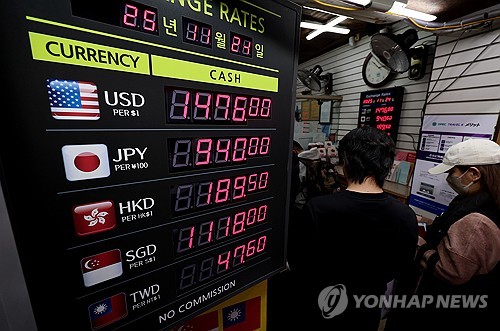

(Seoul=Yonhap Infomax) Yoon Woo Shin – As the South Korean won continues to depreciate, pushing the USD/KRW exchange rate to a seven-month high, analysts note that other major Asian currencies are also struggling to break out of their bearish trends.
In particular, countries directly impacted by the latest wave of US tariff measures have seen their currencies post significant declines since the start of the second half of the year.
According to Yonhap Infomax’s currency performance comparison (screen no. 2116) on the 25th, the Japanese yen has fallen 8.60% against the US dollar in the second half, marking the steepest drop among major currencies.
The New Zealand dollar slipped 8.00%, while the won declined 7.96%, recording the next largest losses. The Taiwan dollar also dropped 6.82%, underscoring a pronounced downward trend.
However, the depreciation against the US dollar is not limited to Asian currencies. Most major currencies included in the dollar index also weakened, including the euro (-2.40%), British pound (-4.62%), Swiss franc (-2.17%), Australian dollar (-1.78%), Canadian dollar (-3.27%), Singapore dollar (-2.48%), and Swedish krona (-0.63%).
Only the Chinese yuan and Hong Kong dollar rose against the greenback, up 0.78% and 0.88% respectively. However, these gains are less meaningful as Hong Kong maintains a dollar peg and China operates a tightly managed floating exchange rate regime with limited fluctuation.
Among Asian currencies, those experiencing the sharpest declines share a common factor: direct exposure to US tariff actions. Countries with high export dependence, such as South Korea, Japan, and Taiwan, have seen their currencies weaken markedly as they agreed to lower tariffs in exchange for large-scale investments in the US.
South Korea pledged $350 billion in US investments after agreeing to cut mutual tariffs and auto tariffs from 25% to 15%, and to apply semiconductor tariffs on terms no less favorable than those for Taiwan.
Japan, similarly, agreed to reduce mutual and auto tariffs to 15% and committed to $550 billion in US investments. These astronomical investment pledges—over 500 trillion won for South Korea and 800 trillion won for Japan—have fueled demand for US dollars, further pressuring their currencies.
Taiwan is currently negotiating with the US to lower its 20% tariff rate, with reports indicating Washington is seeking up to $400 billion in investments.
In contrast, China’s rigid exchange rate regime and its relatively equal footing in tariff negotiations with the US have helped the yuan maintain its value.
Within this external environment, Japan’s currency faces additional pressure from expectations of continued monetary easing, while South Korea’s large-scale outbound investments have intensified the won’s weakness. As a result, analysts say the depreciation is not unique to the won but is part of a broader decline across Asian currencies.
Indeed, with the exception of the Malaysian ringgit and Thai baht, most Asian currencies have fallen against the dollar in the second half, including the Indian rupee (-3.93%), Indonesian rupiah (-3.06%), Philippine peso (-4.33%), and Vietnamese dong (-0.91%).
LS Securities recently assessed the rise in the USD/KRW rate as a reflection of overall Asian currency weakness rather than a won-specific issue.
For this trend to reverse, the dollar’s strength would need to subside, but a shift appears unlikely in the near term. While expectations for US Federal Reserve rate cuts are rising, hawkish voices advocating caution remain strong, making a December rate cut far from certain.
Moreover, the dollar’s safe-haven appeal continues to drive demand whenever risk aversion spikes, making a reversal in dollar strength difficult to anticipate.
Nevertheless, markets remain hopeful for a gradual Fed rate cut cycle and a corresponding decline in the dollar.
Kwon A-min, a researcher at NH Investment & Securities, said, “As external uncertainties ease with Fed rate cuts and a potential Bank of Japan rate hike, the USD/KRW rate is expected to stabilize downward by year-end or early next year.”
LS Securities added, “We see a high likelihood of US government intervention to weaken the dollar. If President Donald Trump’s tariff policies fail to reduce the trade deficit, he may seek to address the strong dollar situation.”
ywshin@yna.co.kr
(End)
Copyright © Yonhap Infomax Unauthorized reproduction and redistribution prohibited.

